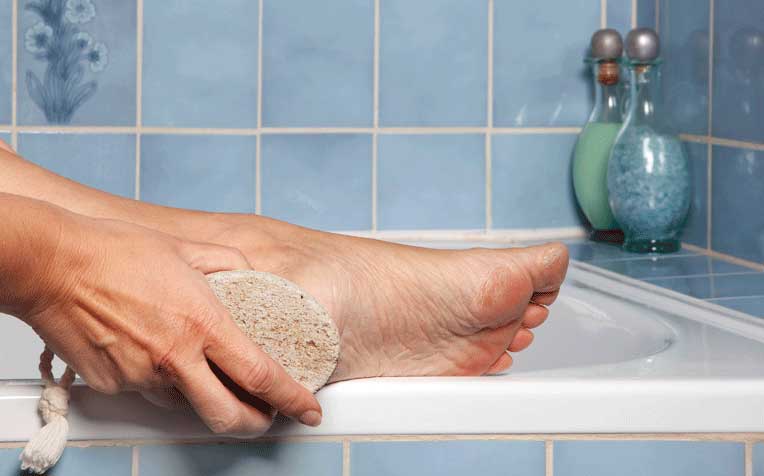
Foot corn and callus can be treated at home.
All about foot corn and callus
It is estimated that on average people take around 4,000 steps per day, which equates to well over a million steps per year. It isn’t hard to imagine the amount of stress placed on your feet. Looking after your feet as much as possible will help prevent foot problems, such as foot corn and callus, which can impact your quality of life.
Corns and calluses are among the most common conditions that can affect the feet. A callus is a diffuse area of thick skin. A foot corn is a localised area of thick skin which usually has a conical or circular shape.
There are two main types of foot corn:
- Hard foot corn is the most common type. It usually occurs over a bony part of the foot such as the forefoot or toes.
- Soft foot corn is often whitish in colour and tends to develop between the toes where the skin may be wet or macerated (broken down).
Why do I have foot corn or callus?
Corns and calluses are caused by repeated excessive pressure or friction on a certain point of the foot. This may be due to ill-fitting footwear, foot deformities or certain walking styles that predispose the foot to increased pressure or friction.
For example, if you have a low-arched or flat foot, this may put more pressure on the inner part of the foot when you walk, which may lead to the development of foot corn or callus on the inner side of the heel.
Does having foot corn or callus mean that I’m going to get pain?
Not necessarily, most people tend to have some form of callus on their feet. However in some individuals, this can lead to some discomfort or pain.
Does foot corn or callus require treatment?
Corns and calluses do not require treatment unless they cause pain.
However, if you have diabetes, peripheral neuropathy or another condition that may cause numbness in your feet, it is important to check your feet daily for any skin breakdown (such as wounds) and to consult your doctor or podiatrist before you try to self-treat foot corn or callus.
What treatments are available?
If you experience pain, you may reduce the size of the corn or callus yourself by soaking your foot in warm water for 20 minutes and then using a pumice stone or foot file to rub the thick skin away. A moisturising cream used regularly on a filed corn or callus will help keep the skin soft and make it easier to rub down the thick skin in future.
If the skin is very thick or causing a lot of pain, it may require help from a specialist, such as a podiatrist, who can pare down the thickened skin using a scalpel blade. The paring down eases the pressure on the underlying tissue, hence the pain reduction.
Removing the foot corn or callus is often straightforward. However, the ultimate goal is to prevent the lesions dues to pressure and friction from returning, which can prove a little more difficult. A number of treatments may be required to achieve this long-term goal, but the cause for the high pressure and friction must first be identified.
2 tips if you're prone to foot corn and callus
- Tight or incorrectly fitting shoes are considered to be a common cause for foot corn and callus. Accordingly, wearing good footwear with sufficient width and depth as well as an adjustable strap may help to reduce any rubbing or friction on your feet and skin.
- Insoles may be manufactured by your podiatrist if the painful foot corn or callus isn’t resolved via regular paring down with a scalpel. Insoles can be used to remove or redistribute the excessive pressure points.
Ref: S13














 Get it on Google Play
Get it on Google Play